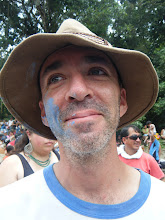I am not sure what Quetzaltenango's city planners and bigwigs were thinking in the late 1800's/early 1900's, but I do know one thing. It is obvious from the most ornate colonial buildings still standing around town that they all definitely had some type of fetish for Greek style architecture. A short walk through town takes us past the city's main buildings where the architects got freaky with columns galore.
Teatro Municipal (Municipal Theatre)
Built in 1894, this place is still going strong with events happening quite frequently. I just went to a free jazz concert here last week. Though the seats are wooden and uncomfortable. I guess the ancient Greeks didn't like cushions either.
The following photos were taken in and around the town's central plaza (parque central) which is adorned with columns on the northern and southern side and a round columned gazebo-type thing in the middle. In Quetzaltenango, the central plaza holds a lot of festivals and events during the year. Interestingly (though not really) there is no Greek festival.
 |
| A doggie beauty competition at the parque central |
The Municipal Palace
The Town Hall was completed in 1895, rebuilt in 1903 after a huge earthquake and sits on the eastern edge of the central plaza.
 |
| Inside the Municipal Palace |
Casa de la Cultura
At the southern end of the parque central is the Casa de la Cultura. It was built in 1870's over a church cemetery, so it kind of makes sense that it now houses the natural history museum full of dead, taxidermied animals and fossils. It was originally used a prison and storage warehouse. In 1955, it became the cultural center that it is today.
Rotunda
Minerva Temple
The Minerva Temple (Minerva is actually the Roman goddess-not Greek, but close enough for my purposes) is a city landmark about a twenty minute walk from the parque central. It was started in 1914 at the behest of the Guatemalan president at the time to symbolize his plans to modernize Guatemala and to create a cultural powerhouse of Central America. The fact that it took until 1973 to complete, is a very fitting metaphor for the pace of modernization and the cultural stalwartness of Guatemala.
 |



















No comments:
Post a Comment